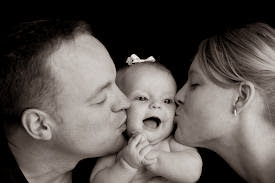 |
| Choice A Baby Girl Or A Boy ? Planning with this guaranteed methods from the expert Check it |
She had grown up in a family of four sisters. She liked sewing, baking, and doing hair and makeup. She hoped one day to share these interests with a little girl whom she could dress in pink.
Simpson, a labor and delivery nurse at a hospital north of Toronto, was surprised when her first child, born in 2002, was a boy. That’s okay, she thought. The next one will be a girl.
Except it wasn’t. Two years later, she gave birth to another boy.
Desperate for a baby girl, Simpson and her husband drove four hours to a fertility clinic in Michigan. Gender selection is illegal in Canada, which is why the couple turned to the United States. They paid $800 for a procedure that sorts sperm based on the assumption that sperm carrying a Y chromosome swim faster in a protein solution than sperm with an X chromosome do.
Simpson was inseminated with the slower sperm that same day. Fifteen weeks later, she asked a colleague at the hospital to sneak in an after-hours ultrasound. The results felt like a brick landing on her stomach: another boy.
“I lay in bed and cried for weeks,” said Simpson, now 36, whose name has been changed to protect her privacy. She took a job in the operating room so she would no longer have to work with women who were giving birth to girls.
Simpson and her husband talked about getting an abortion, but she decided to continue with the pregnancy. In the meantime, she looked for a way to absolutely guarantee that her next child would be the daughter she had always dreamed about. She discovered an online community of women just like her, confiding deep-seated feelings of depression over giving birth to boys. The Web forums mentioned a technique offered in the United States that would guarantee her next baby would be a girl. It would cost tens of thousands of dollars, money Simpson and her husband did not have. Simpson waited until her third son was born. Then she began to make some phone calls.
The conventional wisdom has always been this: Given a choice, couples would prefer sons. That has certainly been the case in places like China and India, where couples have used pregnancy screening to abort female fetuses. But in the United States, a different kind of sex selection is taking place: Mothers like Simpson are using expensive reproductive procedures so they can select girls.
Just over a decade ago, some doctors saw the potential profits that could be made from women like Simpson—an untapped market of young, fertile mothers. These doctors trolled online forums, offering counseling and services. They coined the phrase “family balancing” to make sex selection more palatable. They marketed their clinics by giving away free promotional ebook and setting up slick websites Check it.
These fertility doctors have turned a procedure originally designed to prevent genetic diseases into a luxury purchase akin to plastic surgery. Gender selection now rakes in revenues of at least $100 million every year. The average cost of a gender selection procedure at high-profile clinics is about $18,000, and an estimated 4,000 to 6,000 procedures are performed every year. Fertility doctors foresee an explosion in sex-selection procedures on the horizon, as couples become accustomed to the idea that they can pay to beget children of the gender they prefer.
Inside a fourth-floor office suite off a palm-tree-lined street in Encino, Calif., in an embryology lab, two men wearing maroon scrubs peer into high-tech microscopes. The men are fertilizing human eggs with sperm samples collected earlier that day. After fertilization and three days of incubation, an embryologist uses a laser to cut a hole through an embryo’s protective membrane and then picks out one of the eight cells. Fluorescent dyes allow the embryologist to see the chromosomes and determine whether the embryo is carrying the larger XX pair of chromosomes or the tinier XY. The remaining seven cells will go on to develop normally if the embryo is chosen and implanted in a client’s uterus.
The lab is part of the Fertility Institutes, a clinic set up by Jeffrey Steinberg, one of the most prominent gender selection doctors in the United States. In his spacious, oak-paneled office down the hall, Steinberg is surrounded by photos of his own naturally conceived children. His clinic is the world leader for this gender selection technique, known as preimplantation genetic diagnosis (PGD). “We’re by far number one. Number two is not even a close second,” he said.
The United States is one of the few countries in the world that still legally allows PGD for prenatal sex selection. The procedure was designed in the early 1990s to screen embryos for chromosome-linked diseases. It is illegal for use for nonmedical reasons in Canada, the U.K., and Australia.
Steinberg’s gender-selection patients are typically around 30 years old, educated, married, middle to upper class. They also typically have a couple of children already, unlike the women in his waiting room undergoing in vitro fertilization and hoping to conceive any child at all.
Statistics on gender selection are sparse. A 2006 survey by Johns Hopkins University found that 42 percent of fertility clinics offered PGD for gender selection. But that was half a decade ago, before many clinics undertook aggressive online marketing campaigns to drive the demand.
Gender selection is the primary business at Steinberg’s Fertility Institutes, with nurses casually asking couples in the waiting room whether they, too, are interested in selecting the gender of their baby. Business quadrupled when Steinberg started advertising PGD for gender selection.
Steinberg said he never intended to make gender selection his niche. But then the ethics committee of the American Society for Reproductive Medicine, a nonprofit organization that attempts to set standards in the industry, came out against prenatal sex selection for nonmedical reasons in 1994. The group said the practice would promote gender discrimination and was an inappropriate use of medical resources. That made Steinberg angry.
“I took it on as a challenge,” he said. “The fact that they didn’t like it, and the fact that I saw nothing wrong with it, made me more aggressive.”
He advertised in Indian-American and Chinese-American newspapers. Local groups accused him of stoking cultural biases for boys in those communities, and his ads were pulled by the publishers.
In 2009, Steinberg came under a worldwide media firestorm when he announced on his website that couples could also choose their baby’s eye and hair color, in addition to gender. He revoked the offer after receiving a letter from the Vatican. Steinberg seems to enjoy the attention, whether good or bad. After all, the publicity only helps bring in more patients to his clinics.
Many women who undergo PGD for gender selection discovered the procedure in online forums. Reading the posts on these forums is like entering another world. Users adorn their avatars with pink and princess imagery. They talk about their desperation to have daughters. They share notes on the process of going through PGD, recounting in detail their own experiences: blood-test results, drug effects, in vitro cycles.
Daniel Potter, the medical director of the Huntington Reproductive Center, has written more than 1,000 posts for in-gender.com and answered forum members’ questions about the procedure and its costs. He arranged in-person and phone consultations with forum members, including Megan Simpson. In 2011, he even started a personal website where he calls himself the “gender selection expert.”
From posting on message boards to using Twitter, Facebook, and YouTube, fertility doctors have appropriated 21st-century marketing methods to bring a 21st -century technology to the masses. Competition is stiff for search-friendly domain names for clinic websites and sponsored Google search ads. For example, there’s genderselection.com, not to be confused with gender-selection.com. There’s also gender-select.com and genderselectioncenter.com, all websites maintained by fertility clinics promoting PGD. These sites are filled with glossy stock photos of happy families, polished YouTube videos of doctors making their pitch, and patient testimonials in numerous languages.
In May 2008, Simpson and her husband traveled to California to undergo PGD at the Laguna Hills branch of the Huntington Reproductive Center. There, she met up with some of the women she had made friends with online. “We went shopping and picked out girly clothes and dreamed of the day we could have a baby to wear them,” Simpson recalled.
Three days after arriving in California, Simpson underwent egg retrieval surgery. Eighteen eggs were retrieved; of these, 11 were mature and were fertilized.
Her husband left after the surgery to return home and take care of their three boys. After resting for five days, Simpson returned to the clinic for her embryo transfer.
She was met with devastating news: all of her embryos were found to be chromosomally abnormal. None were useable.
“I cried. And cried some more,” recalled Simpson. “All that money, the drugs, the travel, time off work. The money.”
Despite the financial and emotional setbacks, she wanted to try again, soon. Three months later, she was back in Laguna Hills, this time to try a more sophisticated sperm-sorting method plus in-vitro fertilization. She had taken out $15,000 on a line of credit to pay for the second attempt.
This time, the embryos were good to go.* An ultrasound was used to guide a catheter containing the embryos into her uterus. Six days later, Simpson took a pregnancy test. It was positive.
When she was 15 weeks pregnant, she asked a friend at work to once again sneak her into an after-hours ultrasound. Simpson was anxious, haunted by the memory of her last ultrasound.
But this time, it was different. She was pregnant with a girl.
After nearly four years and $40,000, Simpson’s dreams of being a “girl-mommy” were finally going to come true.
Simpson gave birth to her daughter during a home delivery in her bathtub in 2009. “The moment she was born, I asked if it was still a girl,” she recalled.
Simpson had to work six days a week right up until the delivery and months afterward to repay the loan she took.
“My husband and I stared at our daughter for that first year. She was worth every cent. Better than a new car, or a kitchen reno.”
Much of the evidence that Americans preferentially choose girls is anecdotal, as no larger body tracks gender selection procedures. But data from Google show that “how to have a girl” is searched three times as often in the United States as “how to have a boy.” Many fertility doctors say that girls are the goal for 80 percent of gender selection patients. A study published in 2009 by the online journal Reproductive Biomedicine Online found Caucasian-Americans preferentially select females through PGD 70 percent of the time. Those of Indian or Chinese descent largely chose boys.
So where does this preference come from? And with the sex-selection rhetoric in the United States centered around “family balancing,” a feel-good term that implies couples are rationally planning their families, is it still sexist to choose for girls?
For Dr. Ashley Spencer, the reasons were simple. “I’m not into sports. I’m not into violent games. I’m not into a lot of things boys represent and boys do,” she said. Dr. Alicia is the author of Chasing the Gender Dream, a self-published book that documents her use of gender-selection technology to conceive her daughter.
Interviews with several women from the forums at in-gender.com and genderdreaming.com yielded the same stories: a yearning for female bonding. Relationships with their own mothers that defined what kind of mother they wanted to be to a daughter. A desire to engage in stereotypical female activities that they thought would be impossible with a baby boy.
 |
| Dr. Alicia Peninggton site and choice what the gender baby you want Check it |
“It’s high-tech eugenics,” said Marcy Darnovsky, director of the Center for Genetics and Society, a Berkeley, Calif. nonprofit focused on reproductive technologies. “If you’re going through the trouble and expense to select a child of a certain sex, you’re encouraging gender stereotypes that are damaging to women and girls. …What if you get a girl who wants to play basketball? You can’t send her back.”
Despite the objections from some medical ethicists, it seems that gender selection, like many aspects of fertility medicine, will remain legal and unregulated in the United States.
Look more and learn what the methods best from the expert to choice baby gender you want from Dr. Alicia. Look the books.



















